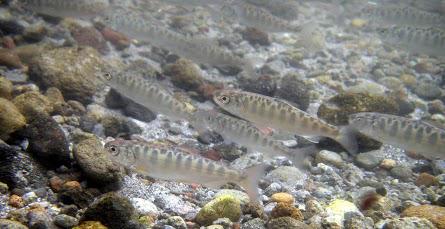Climate change threatens California’s stock of native fish
Coho Salmon, like these juveniles, are one of the most endangered fish species in California. (Photo by Caron Jeffres.)
As summer begins along many U.S. rivers, you’ll find anglers patiently contemplating their rods in the flowing water.
But researchers say when it comes to California, in the future they may be out of luck if they are looking to hook an indigenous fish. A new study from the University of California at Davis finds that many of California’s unique fish species could go extinct if global warming continues at current rates.
Peter Moyle, one of the lead authors on the study, says freshwater fish are especially vulnerable because they have nowhere to escape fluctuations in climate.
“When you’re in a stream, you can only go upstream so far before you run into a waterfall or something, so if the conditions in that stream change, you’re pretty much stuck,” he said.
Moyle says throughout California and the west, streams are predicted to warm by four to six degrees in the summer, with stream volumes becoming more variable. That adds up to very difficult conditions for fish over the next 50 to 100 years.
Moyle, who has done periodic surveys of California’s fish dating back to the 1970s, used his experience to assess native fish on 20 different measures of their long-term vulnerability to climate change.
“When we scored 121 native fishes and 43 non-native fishes, 82 percent of the native fishes are going to suffer heavily from climate change and many of them to the point where they’ll go extinct,” he said.
For many of these species, the decline has already started for other reasons — development, pollution, etc. — and climate change will just accelerate the decline.
The fish that are most vulnerable, Moyle said, require cold water to survive and thrive, many of which are household names: Chinook salmon, Coho salmon and Steelhead trout, as well as species like Delta Smelt and Eulachon.
“Many of these rivers are simply going to get too warm for them,” Moyle said.
Ironically, climate change won’t mean the end of fish in California streams — it’ll actually be a boon to non-native species introduced to California’s rivers over time.
“We’ve been essentially changing things in California ever since the Gold Rush and generally creating warmer water habitats anyway,” he said. “So you’re bring in your catfish, your bass, your carp — species that thrive in warm water environments.”
Ironically, as they thrive more and more, they will put even more strain on native species, hastening their demise.
And while this is undoubtedly bad for the fish, it’s also economically harmful. In the case of certain species of salmon and trout, they’re popular on dinner tables — and raised by farmers.
If the fish go away, the streams will suddenly become less nutrient-rich as fish are no longer living and dying in the streams’ headwaters.
” I did a study once relating what salmon nutrients do to a steam surrounded by vineyards,” Moyle said. “And we found that not only did local wildlife benefit from salmon, we even got photographs of deer coming to munch on salmon carcasses, what we found was that the vineyards alongside the stream actually incorporated marine nutrients into the leaves of the grapes.”
But all is not lost. Moyle said the biggest thing to be done is to upgrade the dams in the state, to allow them to release the cold water that is stored in the lower levels of reservoirs behind the dams.
“When they do that, you’re releasing the cold water that native fishes like salmon really like. So you have to conserve that cold water and use it specifically for fish as long as you can during the summer months,” he said.
